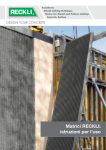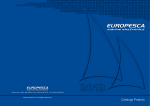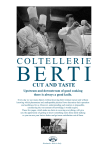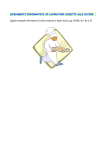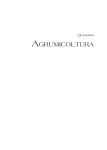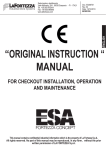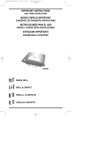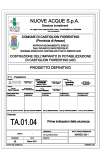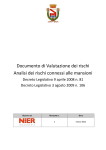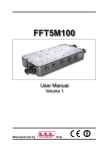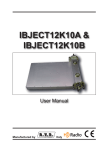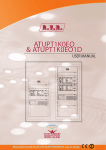Download Coltellerie Berti
Transcript
Handmade. Made in Italy. Coltellerie Berti dal 1895 A.S. Alessio Santoni C.Ca. Cristian Carraro A.V. Andrea Vannini C.D. Claudio Donigaglia D.R. Daniele Rogai G.B. Giorgio Berti M.S. Massimiliano Santoni C.S. Sandra Corsini The work of a sole craftsman. Signed with his initials. Confirming his craft and its value. At Coltellerie Berti, each knife is the finished work of a sole craftsman. Whoever starts the work takes it right through to the finishing touches. This is the essence of the craftsman’s tradition held in the Berti family since 1895, which to this day keeps up the age old tradition of joy in possessing a handmade knife - fruit of a genuine craft. And from today this tradition will proudly state that each and every knife at Berti will bear the initials of the craftsman who made it. A bold declaration of quality and personal craft, which varies from craftsman to craftsman. No two knives are the same or are made in the same time. At Coltellerie Berti we are trying to keep up our age old tradition. Because no one can live without tradition. Andrea Berti Coltellerie Berti dal 1895 “We cannot live without Tradition” In these changing times and customs, each of us needs tangible evidence, true, authentic and unchanging, of our past and History. Because it is this evidence which allows each of us to remember the world we come from and the values which generated it. This need, in its turn, reflects a deeper one: that of achieving recognition of our own and specific way of being in the world, as something unique and unrepeatable and therefore worthy of respect. Many call it Material Culture: we prefer to think that this is simply the way to say that each Man is the fruit of a thought of God. Andrea Berti Handmade. Made in Italy. Coltellerie Berti dal 1895 What is the Coltellerie Berti ? 1895 David Berti 1923 Severino Berti 1945 Alvaro Berti 2005 Andrea Berti The Coltellerie Berti began crafting knives in 1895. Founded by David Berti, for four generations the family has been producing handcrafted knives, without interruption. Starting with the hands of David Berti, his skills were passed on to his son, Severino. Severino’s son, Alvaro, continued to handcraft fine knives. Today, Alvaro’s son, Andrea Berti, continues the Berti family Tradition in the same place with the same, almost religious observance, of the craftsman art handed down from father to son for more than 100 years. Why is the Berti Tradition important? Because we cannot live without traditions. In abstract terms it means that in the void of constantly changing times and cultures, each one of us needs some tangible point of reference to his own past. That being something authentic, that has not changed and will not change in time. This point of reference helps us remember the world we come from and the values it inspired. What does the Berti Tradition mean in concrete terms? In concrete terms, the Berti Tradition reminds us that there still exist values that are different, and more important than those offered by modern day consumerism, such as; the global markets, low cost labour, the lack and loss of interest in maintaining something precious, the frantic acquisition and its inevitable disposal. Traditional values, on the contrary, are those that speak of quality and individuality, such as a knife crafted for a specific job. In the kitchen, this speaks of the pleasure in cutting correctly, while at the same time respecting the ingredients, dishes, and preparation in the kitchen. Traditions not only conserve the art of cutting, but also give us interest and joy in maintaining a fine knife crafted to last. And not just something to be thrown away after a brief period of unsatisfactory use. Coltellerie Berti dal 1895 What is the Deposit of Models of Coltellerie Berti ? The Deposit of the Models of Coltellerie Berti forms a small world and a great Collection: the only one able to fully represent the Tradition Italian Cutler, with the 76 knives of the Italian Regional Collection and the other 600 inherited and servants models in over one century of job, among which we remember: desk knives of the Collection Magnum; Forged kitchen knives with handle in boxwood, or in horn; service knives, among which Italian, the seven essential knives for the correct cut of the over 365 types of Italian cheeses; silver wares, harvests in the Collections for the Table Berti; tagliasigari dedicated to David ; Convivio Nuovo, the smooth blade knife with plastic handle work to hand adopted by the best Italian and European restaurant ; Pontormo, represented in “Cena in Emmaus” of the homonym painter; Valdichiana, the steak knife dedicated to the Chianina. How are the Berti Traditions respected at Coltellerie Berti? By passing down and innovating the great “storehouse” of the knife collection, work methods and crafting skills which have been generated and conserved for over a century within the Berti family. Coltellerie Berti dal 1895 What are the craftsman’s materials and methods that form part of the Berti Tradition? Steel for the blades while Ox horn, Stag horn, Buffalo horn and “bosso” wood are used for the knife handles. And the most important method our Tradition requires is that each knife is the complete work of a sole craftsman. In other words, the hands that begin the work finish it. The work is not divided among different phases and then passed from worker to worker. Our method means that each and every knife crafted is appreciated for the uniqueness of its character, given by the harmony of its form and the minute detail bestowed by its craftsman - making it a testimony to the Berti Tradition. A ‘warehouse’ of tradition that turns a simple hand crafted knife into a genuine Berti knife. The craftsmanship tradition at Berti means that in each of our knives there is the thought, the hand and the presence of a unique person. The family Tradition brings the work experience in to what is truly a human dimension rather than a narrow vision that is coldly technological, economic, and definitively dehumanising. What does passing down the Berti Tradition mean for Coltellerie Berti? It means continuing, despite the immense difficulties it may present, to produce the complete traditional knife collection which forms the so called ‘storehouse’ - as Andrea prefers – and furthermore it means continuing to produce it using only the best of the craftsman’s materials and methods conserved and passed down by the family since the 19th century. What does innovating the Berti Tradition mean for Coltellerie Berti? It means the enrichment of our ‘warehouse’ with new materials and new forms while at the same time maintaining and respecting Berti’s tradition of craftsmanship and more importantly bring in new ideas only if they are quite clearly destined to stand the test of time and in turn become new Traditions. This how our Tradition was born, through a slow and patiently tried and tested selection of innovations, which have brought progress and created lasting values for our people. And this is how the Berti Tradition aims to continue. Coltellerie Berti dal 1895 Does an actual example of innovation according to the Berti Tradition exist? Lucite (plexiglas), a very modern plastic material used to make some handles represents an excellent example of innovation according to the Berti Tradition. The handle of the “Convivio Nuovo” is made from this ultra modern material and can be washed in the dishwasher, something that is regarded very useful in dayto-day life. Yet, however modern this material may be, with all its technical characteristics, we still boil it in hot water to stabilise it and then work it by hand meticulously as we would Ox horn. The reason why we chose to introduce Lucite (plexiglas) was not to reduce production costs, but rather it was to give a simple, yet precious advantage to the ‘Convivio Nuovo’ – dishwasher proof for daily use. What does innovation not mean at Coltellerie Berti? It means not giving in to fashion trends and the passing fads of what is very often called the “cutting edge” of progress knowing how to recognise and develop only those ideas which are born to last and bring about a genuine inspirational change. But above all innovation does not mean betraying tradition by adopting industrial methods in search of greater profit gain through higher sales obtained from low cost production methods and the use of materials of inferior quality. All of which would mean abandoning either in part or even definitively our Tradition of craftsmanship. Why will the production at Coltellerie Berti always remain in Italy? The Berti family and our craftsmen live in Italy and we intend to remain there. The only reason why either the family or the craftsmen would consider moving would be if Italy no longer offered the conditions conducive to our way of working and consequently our way of life. The search for low cost production etc. is fundamentally incompatible with our respect for Tradition, and therefore, inconceivable. Coltellerie Berti dal 1895 Why are the knives made at Berti more expensive than others? Industrially manufactured knives are more economical than the knives produced by Berti for obvious reasons regarding the choice of materials, range of models and the country of origin, which may offer low production costs - in comparison to the hands of experienced craftsmen working within a context that has absolute respect for dignity in the work ethic. The knives at Coltellerie Berti may also cost more than knives produced by alternative artisan methods in so much as a strict observance of the Berti Tradition will not allow compromise or a reduction of production costs and consequently prices. Is there a working example of this? The “Fiorentino” from the Berti Regional Knife collection is a perfect example. In addition to being produced 100% according to the Craftsman’s Tradition, the handle is crafted using only the tip of the Ox Horn rather than using the less expensive lower region of the horn. Even though this means increasing production costs and therefore doubling its price in respect to similar versions made from the lower Ox horn, the “Fiorentino” is the maximum expression of beauty and Tradition. To whom is the Tradition sustained by Coletllerie Berti aimed? It’s aimed at all of those who instinctively recognise, from the heart, the extreme beauty and brilliance of the Berti Tradition and at those who recognise the need for and great value of a knife crafted to cut not only with care and precision but also one which is capable of reminding us who we are and where we come from. Coltellerie Berti dal 1895 For you and your children. Articles made with dedication to quality that over the years become part of our life, are worthy of infinite respect and loving care. We shouldn’t replace them with others of perhaps a lesser quality just for the sake of change, buying something new on a spending spree or a whim. When making our decisions, we should think in the broader sense, and not just on a personal level. In this sense, it’s true that you won’t find justification for purchasing our knives for merely pesonal gratification - our knives are the epitome of exuberance. They are more than just objects purchased on a whim for personal gratification, and give you more than just one person could want intheir lifetime. A pleasure that lasts: longer than what we might imagine being the moment of the average thrill, in other words the time for which we are excited about a new purchase, and see a certain product as new, as something out-of-the-usual from the everyday objects in our life. And even in the case of a person who never tires of quality, our knives last more than a lifetime. Therefore, our knives should be purchased as part of one’s long-term personal strategy. It’s our pleasure to say, they become a family heirloom. So, our knives are for those who buy them, and surely for those who will inherit them. But they are designed and made to be handed down through the family generations. In a word: they are for you, but also for your children. Andrea Berti Handmade. Made in Italy. Coltellerie Berti dal 1895 The Economy of Excellence In a world which, actually only recently, has become full of things to use and throw away, a kind of behaviour which is different from strict consumerism is beginning to take hold. It is a return to what I like to call “the Economy of Excellence”, represented by this formula: Ca = P x q x M P is the purchase price of a product q is the quantity of the product M is the maintenance cost for each product unit purchased Ca is the annual cost incurred to enjoy the product This means that the real cost of a product (Ca) is not simply given by its purchase price, but by the product of such a price multiplied by the times you need to replace and provide it with maintenance during its lifetime. As I see it, modern consumer economy is based on the formula: Ca = P x q x r P is the purchase price of a product q is the quantity of the product r is the number of times you have to purchase it again Ca is the annual cost incurred to enjoy the product From this point of view, one can be fascinated by the low purchase cost and by freedom from maintenance costs, but we soon realise that the real cost of the product (Ca) is considerably increased by the frequent repurchases we have to make after a short period of unsatisfactory use. These formulae clearly show that Berti knives are by no means expensive, since they are designed to last a lifetime with a little maintenance, indeed their ambition is to be handed down to future generations with the added value, not to be neglected, of the Pleasure of Quality, of the use of Excellent products instead of mediocre ones. As our elders used to say, “Better buy goods stuff”, so “ Those who spend more spend less”. It is a completely different view of consumption, of economy, in sum of the world and of life. Andrea Berti Coltellerie Berti dal 1895 Nothing more, nothing less Recently the newspapers published the results of a meticulous analysis on the equipment used by George Mallory and Sandy Irvine, the climbers who, contrary to popular belief, probably conquered Everest already in 1924. These results showed that the woollen, gabardine, cotton and silk clothes worn by the two climbers offered extremely good protection from the cold, even better protection than modern hi-tech materials. We’re sure it’s true. In fact, in many cases, industrialization produces products of a lower-quality than their pre-industrial equivalent, and this is why we are still making our knives in the same way we did in 1895. This has always been something of a fixation for us, we could say a mainstay of our work: moderation. In other words: not adding anything, or inventing strange novelties, without attempting to embellish something which already has its own precise value from the day it was first made. Some however may see our products as something of a luxury. As if cutting meat with the straight edge of a handmade knife, holding the horn handle in your hand was a luxury. We, on the other hand, have always considered this as the way things should be, or should be once more – normal daily life. But if some wish to consider it normal to use serrated edge blades to cut anything other than bread, to believe it is cheaper to spend less on a knife that doesn’t cut well and must soon be thrown away, considering sharpening blades a thing of the past, that is none of our business. Andrea Berti Handmade. Made in Italy. Coltellerie Berti dal 1895 Coltellerie Berti: industry or craftsmanship. Our choices in this direction are the outcome of an underlying philosophy, which has led Coltellerie Berti to face the challenge of providing high quality work in Italy, a heavily industrialized country with high labour costs, not by using technology, but by applying a product culture based on tradition and manual skills, in other words craftsmanship handed down from generation to generation. In these days when the word “Craftsman” is being despoiled of its true and original meaning, Coltellerie Berti is a “Craftsmanship” company, because everybody working there is a “Craftsman”: being craftsmen is substance and not form. This attitude has led us to abolish division of labour, so that each of our knives is made by a single person (Craftsman) in very small quantities. The person who begins a knife therefore finishes it, by himself, making it a unique item. Even though our intention would be to make knives according to the purest knife making tradition of the Berti family, it has been necessary to mechanise each working step in order to avoid loss of quality in the finished product or offset from traditional types. This way, we have managed to produce high quality knives at acceptable prices. The different work stages which can be mechanised without leaving any trace on the final product are those involving preparation of the metal pieces, including the first rough work on the blades. Whereas each knife is mounted and finished, without any division of labour and using totally manual procedures. The value of a knife does not come only from its indispensable capacity to cut, but also from the pleasure for touch and sight which comes from how surfaces have been worked and the materials which have been used. Many industrially manufactured knives cut very well, but often their shapes and the materials used to make them are chosen more because of the need to cut costs, use machinery and facilitate everyday use, than to the need to make their use enjoyable. Coltellerie Berti knives, with their functional limits which oblige us to prefer washing by hand to using machines, and force us to devote a little of our time every now and then to caring for them, designed so we can appreciate the cutting function they were made for, give us back the pleasure of using an object which, to be appreciated, must also be seen as living evidence of the great Italian Knife Making Tradition. Andrea Berti Handmade. Made in Italy. Coltellerie Berti dal 1895 Tradition has a name: Berti. David Berti 1895 Severino Berti 1923 Alvaro Berti 1945 Andrea Berti 1995 The Berti family has been producing knives for over 100 years, since 1895 when David Berti opened his shop in via dell’Oche, in the town of Scarperia. We’ve been producing knives ever since: David was followed by Severino then Alvaro and now Andrea, in this splendid family tradition. Because to be the rightful heirs to this tradition, simply producing knives in Scarperia is not enough: knife making takes time, even a century. Andrea Berti Tradition has a secret: : Craftsmanship. How have the Berti’s traditional knives managed to survive largeindustrial development? There is a secret. Over four generations of craftsmen we have developed a peculiar production process,economizing to the full the use of materials, at the time the most costly resource, and taken advantage of a heritage of human resources, experience. In the past working with horn was a real “industrial” secret. An extremely laborious complex job it endowed the knives with handles of great strength and lightness. Work of this kind was uneconomical and could in no way be achieved through automated production. Hand crafting knives according to tradition has been passed down through the generations unchanged. This is the cutler’s great secret of the Berti’s family. Handmade. Made in Italy. Mozzetta - David Berti 1935 Coltellerie Berti S.r.l.- Via della Resistenza 12 - 50038 Scarperia - (Firenze) - Italia Tel. (+39) 055.84.69.903 - Fax: (+39) 055.84.68.014 - e-mail: [email protected] web: www.coltellerieberti.it C O LT E L L E R I E BE RT I How to choose Knives Upstream and downstream of good cooking there is always a good knife. Every day we use many objects without knowing their intimate nature and without knowing which phenomena and undisputable physical laws determine their operation and usefulness for us .However, understanding such matters is impossible, considering the vast amount of knowledge it would require. These few pages, which make no claim to covering everything, will give you the opportunity of getting to know something more about knife making so you can use your knives better and get more satisfaction out of them. Handmade. Made in Italy. Coltellerie Berti dal 1895 Choosing a knife for home. How to choose Is it normal to use saw blades to cut food other than bread, focaccia and products out of the oven? Is it really parsimonious to spend less for a knife that cuts badly and that you later have to throw away? Is it really an idea of the past to have high quality blades sharpened ever now and then, so you can still count on an excellent cutting tool through time? Is it a luxury to cut meat at the table with a hand made, smooth-bladed knife having a handle made of horn? We think not. This is why we feel it our duty to illustrate the essential cutting requirements with good knives, to all those who want to choose a knife set from our Collections. You can choose among preparation, serving and table knives with: Stainless steel blades with a high degree of carbon to ensure a long lasting cut. Handles made of horn or quality wood for those who want the most. Hand processed plastic blades, good for washing, also in the washing machine. To provide every kind of cut you may want. Coltellerie Berti dal 1895 Basic information To cut large slices of meat, you can grasp the handle in the palm of your hand and let the blade slide through its whole length. To cut cheese, grasp the handle in the palm of your hand, put your other hand near the tip and then sway a little to push the blade into the cheese without letting it slide. To apply greater force with less effort, when cutting you can grasp the blade where it enters the handle, using index finger and thumb. Finally, a Carving Knife may be used for mincing by grasping the handle in the palm of your hand and resting your other hand on the tip, so as to make it easier for the blade to sway on the cutting board. Material for the handle: natural materials (horn or wood) are beautiful, but the inevitably age soon. There are many qualities of plastic: polycarbonates, economical and sturdy, age more quickly than polymethyl acrylate (plexiglas), which is more expensive but better looking and longer lasting. Plastics can be washed in a washing machine, though this is never advisable for a knife. Material for the blade: the most commonly used is stainless steel, which came into massive use over fifty years ago, to solve the problem of rusting and the lemon flavour which old carbon knives used to leave in food. To ensure cutting capacity and long lasting sharpness, you must choose stainless steel knives with a high percentage of carbon (over 0.40%), however the higher the carbon percentage, the less it will prevent rusting. Avoid 100% rust proof knives, since their steel is not suitable for cutting. The surface may be either mirror polished or satinated. Mirror polish is prettier when new, but it ages quickly, whereas satinated polish preserves its initial appearance longer and ensures that what is cut sticks less to the blade. Recently, knives have been introduced with ceramic blades, which put an end to rust problems once and for all and guarantee long term sharpness, but they are fragile and inevitably will cease to cut in the end, as sharpening is not easy. Size of knives: one must not be afraid of purchasing “large” knives. As a general rule, a knife should be twice as long as whatever one wants to cut. Maintenance: knives do not require much maintenance. If you use them properly, it will be enough to sharpen them after several years’ use. Remember that it is preferable to wash them by hand, but in any case they must be immediately dried. Their shape, thickness and the steel they are made from do not allow them to be used as levers to open tins, or in any case for any use other than cutting food. Coltellerie Berti dal 1895 The indispensable set. Carving knife: this is normally the most frequently used one. It is best to have two: one at least 15 cm long for vegetables and fish, and one at least 20 cm long for meat and cheese. Carving knives should be grasped in different ways, depending on the cut one needs to make. Bread Knife: at least 20 cm long with straight spine and cutting edge, the only one with saw cut. Grip the handle in the palm of your hand and let the blade slide along all its length. Slicing Knife: at least 22 cm long with straight spine and curved tip, smooth cutting edge. Grip the handle in the palm of your hand and let the blade slide along all its length. Paring knife: this is an all-duty kitchen tool, with a strictly smooth cutting blade, at least 10 cm long, with a centred tip. This knife can be used to peel, make incisions and small cuts. Tomato and Citrus Knife: normally saw edged, must be at least 12 cm long. Table Knife: often the most neglected when choosing, this must absolutely have a smooth cutting edge so as not to break the fibres of the meat and not squeeze out its taste, as happens with saw shaped blades. In order to enjoy the full flavour of dishes, use a soft yet determined cut. Don’t throw it away when it loses its cutting edge, as happens with saw shaped blades, which cannot be sharpened. Carving fork: absolutely necessary if you don’t want to use your hands to hold roast and other meat when cutting. Coltellerie Berti dal 1895 The ideal set. Preparation Knives Serving Knives 1. Chef’s Knife: 1. Ham Knife: this knife is normally very large and is used to cut every flexible and long blade, indispensable for cutting ham, kind of meat, as well as cheese and vegetables. cold cuts and roast beef which need to be cut in thin slices. 2. Fish Knife: centred tip, flexible, very sharp, for cutting fish fillets. 2. Bread Knife: this is the only one with a saw shaped blade. One can also use it for dry-fibre pastry, such as pies. 3. Crush Knife: 3. Carving knife for meat and cheese: this is the best alternative to the mezzaluna, to finely smaller than a chef’s knife, it is similar and mainly used mince vegetables. for table service. 4. Carving knife for vegetables: 4. Roast Knife: smaller than the chef’s knife, but similar and mainly the blade has a curved and cutting tip. Great cutting used for vegetables. capacity, prevents breaking into crumbs or splitting the slices. Saw blades are strictly forbidden. 5 Boning Knife: 5. Sharpener: sharp and stiff blade for removing bones and cleaning absolutely necessary to keep knives always in cutting meat of whatever may be inedible. shape. 6. Straight Sparing Knife: 6. Carving fork: the jack of all trades for the kitchen. Strictly with a a complement to the slicing knife, it keeps what you are smooth blade and centred tip, the ideal for small cuts slicing in place. and indispensable for preparing meat and vegetables. 7. Tomato Knife: 7. Curved Sparing Knife: if you don’t have this, you can’t peel, clean, make inci- when cutting tomatoes, you can break the rule which says you must use only smooth blades in the kitchen, sions or scrape. Mainly for fruit and vegetables. by using this knife, which with its teeth helps to make incisions in the film covering tomatoes. Coltellerie Berti dal 1895 The table set. Table Knife: only with smooth blade to prevent squeezing and defibring what is cut. Thanks to the ease with which they are manufactured, and hence their low cost, they have imposed saw shaped blades on every table, but if you want to get the full flavour of your kitchen preparations, the only knives you should put on the table must have smooth blades. Coltellerie Berti offers a wide range: Convivio Nuovo Intero Plenum Duemiladodici Valdichiana Compendio Gualtiero Marchesi Posate del Marchesino ‘500 Italia Beyond the ideal knife set. Once you have got the 12 knives needed to make precise and sure cuts, you can choose, according to your personal taste, some of many kinds of knives to round off your set. Kitchen Knives Coltello da Coltello salmone daColtello salmoneda salmone Disosso cm.Disosso 13 cm. Disosso 13 cm. 13 da Coltello salmone da Disosso Disosso 13 Salmon Knife knife 13 cm Coltello daColtello salmone Coltello da Coltello salmone da salmone salmone Boning Disosso cm. Disosso 13long cm. cm. Disosso 13 cm. cm. 13 13 Manaretta ManarettaManaretta Cleaver Manaretta Manaretta ManarettaManaretta Manaretta Coltello pasta Coltello pasta Coltello pasta Coltello Coltello Coltello pasta Coltellopasta pasta Coltello pasta pasta Pasta Knife Trinciante cm. Trinciante 22 Trinciante cm. 22 cm. 22 Trinciante Trinciante cm. cm. 22 knife Trinciante cm. Trinciante 22 Carving Trinciante cm.22 22 22 cm.cm 22long Coltello da Coltello filetto daColtello filetto da filetto da Coltello filetto Coltello daColtello filetto Coltello da Coltello filetto da da filetto filetto Fillet Knife Coltello perColtello sfilettareper Coltello sfilettare per sfilettare per Coltello sfilettare per Coltello perColtello Coltello sfilettare per Coltello sfilettare per sfilettare sfilettare Filleting Knife SpelucchinoSpelucchino Spelucchino Spelucchino Paring knifeSpelucchino Spelucchino Spelucchino Spelucchino Coltello da Coltello agrumi daColtello agrumida agrumi Coltello Coltello agrumi Citrusda Knife Coltello agrumi Coltelloda da Coltello agrumida da agrumi agrumi Cheese cutting Knives: Coltello da paste Coltello dure da paste dure Coltello da paste Coltello molli da paste molli Coltello da paste Coltello semidure da paste semidure Coltello da paste dure Coltello da paste molli Coltello da paste semidure Knife for half-solid cheeseColtello daKnife hard cheese Knife forda soft cheese pastefor dure paste molli Coltello da Coltello paste semidure Coltello da paste dure Coltello Coltello da paste molli Coltello da paste semidure Coltello da paste dure Coltello da paste molli da paste semidure Coltello da paste dure Coltello da paste molli Coltello da paste semidure Il trapezio per iIlformaggi trapezioIl per i formaggi trapezio per i formaggi La spatola per gli La spalmabili spatola gli spalmabili L’archetto per iL’archetto tenerissimi per i tenerissimi Il trapezio per ialto formaggi L’archetto per i tenerissimi Laper spatola per gli spalmabili Ilscalzo trapezio per i formaggi Il trapezio per i formaggi dallo scalzo dallo alto scalzo alto La spatola per Il trapezio per i dallo formaggi gli spalmabili L’archetto per i tenerissimi La spatola per gli spalmabili L’archetto per i tenerissimi La spatola per gli spalmabili L’archetto per i tenerissimi dallo scalzodallo alto scalzo altocheese scalzodallo alto La spatola gli spalmabili Trapeze for high bowed Wideper spreader Bow forL’archetto soft cheeseper i tenerissimi dallo scalzo alto Coltello da paste Coltello compatte da paste compatte Coltello da paste compatte Coltello da Coltello paste compatte da paste compatte daColtello pastecompatte compatte Coltello da paste Knife for compact cheese Coltellerie Berti dal 1895 Pastry Knives: Coltello perKnife crostate Coltello per crostate Tart Coltello per crostate Coltello per Torta Sacher Coltello per TortaKnife Sacher Sacher Cake Coltello per Torta Sacher Coltello per Coltello crostate per crostate Coltello per Coltello Torta Sacher Coltello per crostate Tortaper Sacher Coltello per Torta Sacher Coltello perColtello crostateper crostate Coltello perColtello Torta Sacher per Torta Sacher Paletta Paletta Torte per Torte Cake per Slice Paletta Torte per Paletta Paletta per Torte per Torte Paletta per Torte Paletta perPaletta Torte per Torte Paletta per Pasticceria Coltello per Millefoglie Coltello per MoussePaletta perPaletta per Pasticceria Mignon Mignon Coltello per Millefoglie Coltello per Mousse Pasticceria Mignon Coltello per Millefoglie Coltello per Mousse Millefoglie Knife Mousse Mignon Pastry Paletta perSlice Pasticceria Coltello per Coltello Millefoglie Coltello perKnife Mousse per Mousse Paletta per Pasticceria Mignon Coltello per Millefoglie Mousse Paletta per Mignon Pasticceria Mignon per Millefoglie Coltello per Coltello Paletta per Pasticceria Mignon Coltello perColtello Millefoglie Coltello per Mousse Paletta per Pasticceria Mignon per Millefoglie Coltello per Mousse Coltello per Cioccolato Martello per Martello per Cioccolato Coltello per Cioccolato Martello per Cioccolato Coltello per Cioccolato Cioccolato Coltello per Coltello Cioccolato perMartello Cioccolato Coltello per Cioccolato per Cioccolato per Cioccolato Martello Martello per Cioccolato Coltello perColtello Cioccolato Martello per Cioccolato per Cioccolato Martello per Cioccolato Chocolate Knife Chocolate Hammer Handmade. Made in Italy. Mozzetta - David Berti 1935 Coltellerie Berti S.r.l.- Via della Resistenza 12 - 50038 Scarperia - (Firenze) - Italia Tel. (+39) 055.84.69.903 - Fax: (+39) 055.84.68.014 - e-mail: [email protected] web: www.coltellerieberti.it C O LT E L L E R I E BE RT I CUT AND TASTE Upstream and downstream of good cooking there is always a good knife. Every day we use many objects without knowing their intimate nature and without knowing which phenomena and undisputable physical laws determine their operation and usefulness for us .However, understanding such matters is impossible, considering the vast amount of knowledge it would require. These few pages, which make no claim to covering everything, will give you the opportunity of getting to know something more about knife making so you can use your knives better and get more satisfaction out of them. Handmade. Made in Italy. Coltellerie Berti dal 1895 Book V Verses 1240-1295 Lucretius, 1st century BC De Rerum Natura ....... Now for the rest: copper and gold and iron Discovered were, and with them silver’s weight And power of lead, when with prodigious heat The conflagrations burned the forest trees Among the mighty mountains, by a bolt Of lightning from the sky, or else because Men, warring in the woodlands, on their foes Had hurled fire to frighten and dismay, Or yet because, by goodness of the soil Invited, men desired to clear rich fields And turn the countryside to pasture-lands, Or slay the wild and thrive upon the spoils. (For hunting by pit-fall and by fire arose Before the art of hedging the covert round With net or stirring it with dogs of chase.) How so the fact, and from what cause soever The flamy heat with awful crack and roar Had there devoured to their deepest roots The forest trees and baked the earth with fire, Then from the boiling veins began to ooze O rivulets of silver and of gold, Of lead and copper too, collecting soon Into the hollow places of the ground. And when men saw the cooled lumps anon To shine with splendour-sheen upon the ground, Much taken with that lustrous smooth delight, They ‘gan to pry them out, and saw how each Had got a shape like to its earthy mould. Then would it enter their heads how these same lumps, If melted by heat, could into any form Or figure of things be run, and how, again, If hammered out, they could be nicely drawn To sharpest points or finest edge, and thus Yield to the forgers tools and give them power To chop the forest down, to hew the logs, To shave the beams and planks, besides to bore And punch and drill. And men began such work At first as much with tools of silver and gold As with the impetuous strength of the stout copper; But vainly—since their over-mastered power Would soon give way, unable to endure, Like copper, such hard labour. In those days Copper it was that was the thing of price; And gold lay useless, blunted with dull edge. Now lies the copper low, and gold hath come Unto the loftiest honours. Thus it is That rolling ages change the times of things: What erst was of a price, becomes at last A discard of no honour; whilst another Succeeds to glory, issuing from contempt, And day by day is sought for more and more, And, when ‘tis found, doth flower in men’s praise, Objects of wondrous honour Now, Memmius,how nature of iron discovered was, thou mayst. Of thine own self divine. Man’s ancient arms. Were hands, and nails and teeth, stones too and boughs—Breakage of forest trees— and flame and fire. As soon as known. Thereafter force of iron And copper discovered was; and copper’s use Was known ere iron’s, since more tractable Its nature is and its abundance more. With copper men to work the soil began, With copper to rouse the hurly waves of war, To straw the monstrous wounds, and seize away Another’s flocks and fields. For unto them, Thus armed, all things naked of defence Readily yielded. Then by slow degrees The sword of iron succeeded, and the shape Of brazen sickle into scorn was turned: With iron to cleave the soil of earth they ‘gan, And the contentions of uncertain war Were rendered equal. ....... Coltellerie Berti dal 1895 Knives from earliest times to the present day. According to the most recent theories, the first families of apes which had come down from trees and begun to take a standing posture date back to five (some say 7.5) million years ago. It was precisely this new posture, which freed the upper limbs and especially the hands from having to contribute to locomotion, which opened up the way for transforming a not yet anthropomorphous ape into a hominid. Our ancestors took several million years to specialise, making headway by trying again and again to create tools using materials easy to work and to find, such as bone and wood. Only two million years ago did they develop the skills for using stones to make tools which, thanks to their nature, have survived until the present day, providing us evidence of the existence of a great many kinds and shapes. The most ancient tools were quite simple, roughly made and used for defence or attack against animals or also against fellow human beings in order to gain control over territory. During this period, human beings acquired the ability to make tools to satisfy their needs. Tools which, though knapped on one face only, during the following half million years progressively became more precise and symmetrical, revealing skill and creativeness. Already 1.5 million years ago, items/tools existed which differed according to their use; and in the following 500.000 years, people began producing tools which were bet- ter worked and knapped, and could simplify everyday operations especially involving hunting, cutting slices of meat, making rudimentary spears able to strike animals from far away. About one million years ago, our ancestors had not only learned how to identify suitable flint for making tools, they had also learned how to shape them by striking them with another stone, knapping them until they could fit into wooden handles. Our hominid thus fashioned the first lasting handmade “object”, the first product of craftsmanship in history: the knife (it might be more accurate to say a piercing and cutting tool, but please allow me this exaggeration!). As beautiful as modern sculptures, they were also suited to the purposes for which they had been designed. The so-called age of polished stone was the first great technological revolution of all time, the first step towards the affirmation of “homo sapiens”. There followed a crescendo not only in the technique of knapping, but also in that of polishing. The latter operation was carried out by rubbing, providing the knapped stone with a sharp end or spears and arrows with pointed tips; awls and scrapers were made to work on leather, drilled axes, clubs, hand-axes. Skilful knapping, experience built up through time increasingly improved the tool – our hominid, after having discovered the best way to work, stored these procedures in his expanding brain and tried to repeat such daily actions, improving them and handing down know how to his descendants. The stone age came to an end in different times and places, due to strictly local tech- Coltellerie Berti dal 1895 nological improvements, but also to the availability of special stones such as flint (present in France and Britain) or obsidian (a fragile but hard glassy pebble of volcanic origin, to be found exclusively on the islands of Lipari, Pantelleria, Sardinia, on the Aegean island of Melos, in Anatolia, Armenia and in the Carpathians). It is curious to note that some of these simple tools were found in places where the raw material does not exist – this means that there was trade between far-away tribes. Many years would still elapse (about one million) before the discovery of metals (casting of copper, about 8000 years ago) permitted a technological leap forward in making weapons and cutting tools. With bronze (an alloy of tin and copper) first (about 5500 years ago) and then with iron (when progress in metallurgy, about 3200 years ago, made a kind of iron available which could compete with bronze), it became possible to make weapons and knives having specialised shapes according to their use, and fitted with comfortable and strong handles which ensured their prolonged use. Bronze and iron are “soft” metals, not especially suited for making weapons and knives which have to suffer blows and go on cutting as long as possible, however they continued to be used for many centuries, since it was impossible to replace them with better materials. Though cast iron, an iron-carbon alloy with a high carbon content, was already known 3000 years ago because it came “naturally” from casting iron contaminated by the carbon present in the coal used to melt the mineral, and was harder than iron, it was impossible to use because of its being so fragile and hard to work that it was called “ferraccio” or “worthless iron” in Italy. Already some 1700 (or according to some, 2200) years ago there existed in India the technique of enriching iron with carbon in a crucible to obtain the alloy known as Wootz steel, but this technique came to the West so slowly that it appeared in Europe only in the 18th century (just 300 years ago!). Until then, in Europe, the only technique known to improve the quality of “cutting iron” was to use pure iron in order to make welded Damascus steel employing cast iron with a higher carbon content: this was an extremely costly method, and did not allow for making very large pieces, at the most as large as a sword blade. This technique could therefore be used only for making “important” weapons, and not for everyday tools which continued to be made using iron with more or less carbon content on the forge, depending on the skill of the “master knife maker”. The technique for producing welded Damascus steel was mysteriously forgotten in Europe between the 5th and 16th centuries, and was discovered again during the Renaissance, when the myth spread that swords held by the Saracens in Damascus and seen by the Crusaders had marvellous properties, because they were made using welded Damascus steel. Actually, an analysis of the weapons which have survived from the battlefields of those days show that it was not so. It seems that the Wootz technique had been refined so as to absorb carbon, especially on the edges of the sword, Coltellerie Berti dal 1895 while keeping the core relatively mild. This afforded a sword which was flexible enough to stand up against blows without breaking, while providing a very sharp blade which kept a cutting edge for a long time. The difference in carbon content between the edge and the core of the sword created a pretty wavy pattern on the surface, hence the term damasqued. So we may say that techniques used to make steel for “cutting irons” were developed, introduced and sometimes lost in different places and at different times, but in Europe, steel having a good and stable quality has been available only since 1740. Since 1740, steel production has been perfected, making it possible to produce high quality steel with a controllable carbon content and which can easily be worked. The kind of steel we have been talking about so far is what is called “carbon steel”, which rusts and which, if brought to the lips, has a strongly citrous flavour, which it also passes on to food which it comes into contact with. It was only in 1913 that Harry Brearley in Sheffield discovered that a steel sample with little carbon but with an addition of 13-14 % chromium did not rust when exposed to the atmosphere: it was the first stainless steel in history. However, one has to wait until 1921 to see the first stainless steel knife, made by in the US by the International Silver Company. Actually, this new material began to be used for cutting irons, especially those used in surgery or for food consumption, only in the 1950s (just 70 years ago!), because of the difficulty of achieving a kind of steel both rustproof and capable of cutting at the same time. Even now, though very sophisticated stainless steel which can cut well does exist (but is not 100 % rustproof), many people still have an unfounded distrust of stainless steel. Of course many other materials have been added over the last century, to make “cutting irons” (titanium, special steels, sintered steels, even plastics, etc. etc.) which are very good but are meaningful only if used for special production requiring specific features. A different matter is the use of ceramic to make kitchen knife blades, the latest technological frontier in kitchen cutlery during the last 30 years. This uses zirconium oxide powder pressed at 400 Tons and sintered at 1350 °C providing a very hard blade, very hard to model but, when once made it cuts wonderfully. The main limits of such knives lie in their fragility and in the impossibility of sharpening them again when, inevitably, they lose their cut after prolonged use. Fashionable today and highly praised by those who sell them, apart from their undisputed quality, they should be used only to cut food which is not too hard and has no bones, making cuts which do not require the slightest bending or twisting of the blade. There must never be falls or blows. Coltellerie Berti dal 1895 The art, use and tradition of Italian knives. The good user of knives. Before giving specific instructions on how to choose the right knives for your needs, we can draw up seven points on basic behaviour and notions which will help you to become a “good knife user”: 6. Nearly all knives today are made of stainless steel: so you can wash them, but you must dry them off (good stainless steel still has a rich carbon content and can occasionally stain). 1. Don’t deceive yourself: no knife exists which can cut everything (and it would be sad too: imagine if there were only one kind of wine”), no knife exists which can do without sharpening, no knife exists which is indestructible. 7. If you don’t want to do without using a washing machine, at least place them in such a way that they do not strike against each other or against other items which could compromise their sharpness during washing; and dry them by hand when the wash finishes. 2. To cut pleasantly and get good results, you must know your knives and what use they were designed for. Upstream and downstream from a good kitchen there is always an excellent knife and its proper use. 3. A knife must never be used for wrong purposes (screwdriver, can opener, cutting deep frozen products or breaking bones, etc.) as this is the surest way to ruin the knife and hurt yourself. 4. Keeping knives perfectly sharp makes them less dangerous (no need to force a cut dangerously). 5. Use them on firm surfaces and always put them away in safe places, never throwing them in with all the other kitchen accessories. Knives too come in categories. Knives have been with us since the dawn of civilisation and perhaps the naturalness with which we live with them leads us to underestimate them, forgetting to try to understand how to use them really, or the specific uses of the various kinds which manufacturers offer us. On the other hand, it is true that knives are hardly ever sold with a user manual, as though manufacturers took it for granted that everybody knows how to use them properly. Nothing could be farther from the truth. Many people, of every social class, use a single knife to do everything in the kitchen, they do not care about what they use to cut with at the table, and they inevitably end up by complaining about the poor results they get when cutting. Actually, every good cut begins with the choice of the right knife. Without claiming to be exhaustive and being aware that we are neglecting many issues, in order to put you in a condition to choose the knives you need, in a simple way but knowing what you are doing, we can start by distinguishing the main features of Table and Kitchen knives. Coltellerie Berti dal 1895 Making knives with a saw blade for Table and Kitchen use is a relatively recent custom. Saw blades have become widespread only because they are cheaper, being made in great quantity with totally automatic processes. When cutting food, one can see that a smooth edge is more pleasant and cleaner when cutting, though this means it will be more costly to buy and maybe need to be sharpened a little more often. It may seem a bit intellectual to feel uncomfortable when using one’s teeth to rip the food we are going to eat on the plate, submitting it to a further useless sacrifice (before it came to our dish, it was an animal or a vegetable which sacrificed its life to nourish us); but it is surely more immediate to note that when we cut meat, vegetables and cheese using serrated knives, fluids come out which contain a major part of the flavour and nourishment which instead of being eaten, will stay in the dish. In the kitchen, once we know that a saw blade knife is needed to cut bread, we must distinguish smooth bladed knives according to their body and the geometry of their edge (the final cutting part of the blade): Wedge shaped body and convex edge: this is the most ancient and common shape for a blade and its edge, but it is also the most versatile. Knives with this kind of edge ensure long lasting cut and easy sharpening. They are suited for cutting raw and cooked meat, fish, cheese and vegetables This kind of sharpening can be done only by hand. Rectangular body and double wedge edge: this is the feature of knives which are not very flexible but are strong and are suited to withstand the blows typically incurred by bone breakers. Wedge shaped body and simple wedge edge: this is the feature of knives which cut very sharply and are flexible. The limits of such blades are that the cut is short lasting and they are fragile, making them suited for cutting (filleting) fish and vegetables (food without a strong body, where cutting must be made in a very delicate manner in order to preserve structure and taste). Serrated blade: purchase these only to cut bread or any other dry-fibre oven product. They are not suitable for any other kind of cut, since the saw blade tends to break fibres and let fluids out from the food we are going to cook or eat, leading to a loss of flavour and nourishing substances. Serration also has the unpleasant effect of leaving ugly “claw marks” on what it cuts. Smooth blade: the only kind suited to cut meat, fish, 1.Wedgeshaped body and convex edge. vegetables, fruit and cheese. A smooth-bladed knife cuts softly, with the greatest respect for what is supposed to nourish us, preserving every touch of flavour and nourishing capacity. 2. Rectangular body and double wedge edge. 3. Wedge shaped body and simple wedge edge Coltellerie Berti dal 1895 We suggest you don’t let yourself be amazed by special effects, purchasing knives with original and “strange” blades and edges. If you really want to enjoy the satisfaction of purchasing a knife which is guaranteed to be just right for a specific use, do it only after you have bought the full set of knives which are indispensable for your kitchen: this way, you can be sure to make good cuts. The surfaces of the blades give a nice appearance to the knife, and choosing sober and effective working ensures the results will be good. Therefore, you can choose knives among those which have the following kinds of blade surfaces: using the point, and one wants to get slices by sliding forward. Or else in the case of cheese which is cut only by pressing and not by sliding. Or for certain ways of cutting vegetables and fruit. Handle: this decides how comfortable the cut will be, so it must fill your hand well, and allow you to grasp it an easy and sure way, so the knife will never slip from your hands. In the case of handles, too, sober shapes are a synonym of functional efficiency, if we are looking for beauty, it is better to choose nice looking materials (horn, wood, special plastic) rather than look for “amazing” shapes. Thickness of the blade: knives must be as thick as Satin finish: these are the most common today, due necessary for what they are cutting. For kitchen use, to the need to simplify the manufacturing process. They were also successful because their surface aging is less than those of mirror polished blades. It makes it harder for cut food to stick to the blade Mirror polished blades: these look very beautiful, they increase rustproofing, but they are easily scratched when they touch each other and during cutting. During cutting, food tends to stick to the blade causing unpleasant and sometimes dangerous deformations on what you are cutting. thin blades will cut and penetrate better, but will be delicate, so they must be used for food (fish and vegetables) which have easily cut fibres and which could be damaged by rougher cuts. Medium thick blades will be used for meat and thick ones to break bones. Size: don’t be afraid to buy “big” knives, it is a good rule to use a knife twice as long as what you want to cut. Forged blades: these are the most prestigious and beautiful. Obtained by forging – today using a mallet, Point: It may seem strange, but knife points exist not by hand – they once ensured better cutting quality basically “because a blade has to finish somewhere”, only in some cases does it have to do with some specific task, it usually simply sets the appearance, the style of the knife. In this case too, I would distrust esoteric looking tips and for my kitchen, I would choose among the following: Centred point: ideal for paring knives used to prepare meat and have specific functions which call for piercing. They are also ideal for carving knives. Scimitar point with straight spine: the ideal for cutting large slices of raw or cooked meat, when one needs to slide forward while cutting and entering, helping oneself with the point. Round or square point: the ideal for raw or cooked meat knives where one does not have to enter first since forging gave a uniform and fine grain which improved the cutting capacity and duration of the knife. Mallet blows break up and give order to the steel molecules. Be careful when choosing such knives: “fake” ones exist, stamped with a fake knot added only for reasons of appearance. Generally, forged knives are more expensive. Coltellerie Berti dal 1895 Stamped or laser cut: originally designed to save money and make for easier production, they were once thought to be of poor quality, however today they have acquired a different esteem, since technological progress has made it possible to use steel alloys to make stamped knives which give a very high blade quality (fine and orderly granulometry without forging). It is in any case hard to choose a knife of the right quality among stamped ones – we suggest you refer to a reliable dealer. The fact that it is easier to make knives this way has led to a wide range of productions: unhardened blades, pre-hardened, pre-conified etc. , the quality of which is very dubious. Material of the blade: the most widely used is stainless steel, which came massively into use over 50 years ago to solve the problem of rusting and the citrous flavour left on food by old carbon knives. To get the right cutting capacity and make sharpness last, you should choose stainless steel knives with a high percentage of carbon (more than 0.50%) however the higher the percentage of carbon, the less rustproof it will be. Don’t trust 100% rustproof knives, because their steel will not be suitable for cutting. The surface may be either mirror polished or satin finished: mirror polish is prettier when new but it ages quicker, whereas satin finish preserves its initial appearance longer and prevents cut material from sticking to the blade. Recently, knives have appeared with ceramic blades which finally solve the problem of oxidation and ensure long lasting sharpness, but are fragile and when they will inevitably cease to cut, they will be hard to sharpen. Material of the handle: natural materials (horn or wood) are pretty and nice to touch, but inevitably they age quickly, require care when being used and make it necessary to wash them delicately and by hand. Many qualities of plastic – widely used today – exist. They are nearly always polycarbonates, cheap and strong, but which age quickly and only come in opaque and dark colours. Polymethyl acrylate is less used, because it costs more and is harder to work on, but it provides lively and brilliant colour with a nice glossy appearance which lasts a long a time and stands up well to washing. A plastic handle makes washing by hand easier, but also using a washing machine; however, if you want to keep the blade of your knife both efficient and pretty for a long time, it is always better to wash by hand. Coltellerie Berti dal 1895 Instructions To get the best out of your knives. Using a knife of quality is essential for the best cuts, but it’s also important to follow some simple instructions. Low quality knives are best-suited to withstanding poor cutting techniques and lack of maintenance. Every knife should be used for the purpose it was intended for. The shape, the thickness and the steel the knife is made of, make them unsuitable for using as levers: never try to pry open jars or remove crown stoppers, or put a sideways force on a knife to try and “break apart” what you’re cutting: you can’t cut a whole mature cheese with a paring knife! There are short-bladed knives with suitably dimensioned handles, designed for this sort of thing. A knife can only be used to cut food by sliding the blade across it while applying pressure from above. If you find yourselves using “force” to cut, you’re using the knife in the wrong way, and may end up breaking it or even hurting yourselves. Don’t “throw” your knives in a drawer with a thousand other things if you want to keep them in good shape and as sharp as they should be. There are special drawers designed for knives, but if you don’t have one get a “Block”. Washing the knife by hand after use and drying it carefully after washing are the secrets to keeping your knives in top form for a long time: use warm water (40°C), a non-aggressive detergent, and dry the knife imm ediately after washing it. If you don’t wash a knife after using it, leaving food residues on the blade until the next day, you may be in for an unpleasant surprise and find unsightly reddish stains and black marks on it which, while not exactly rust, are nonetheless still produced by carbides forming on the surface. Coltellerie Berti dal 1895 Never leave your knives to drip dry after washing: this is one sure way to stain them with marks over some or most of the surface. These marks may be caused by contamination during the wash or in the worst cases by an actual attack on the steel. Water with a high iron content leaves deposits. Knives that don’t have natural handles can also be washed in the dishwasher, taking care to position them so they can’t knock against each other and using a short/delicate wash cycle (max 60 ° C - 140 °F), but you should also bear in mind the possible consequences: dishwashing makes the objects washed in the machine age quickly, the higher the quality of a steel blade - the less stainless the steel will be, so the blade can become stained with small reddish or large bluish marks. Always dry your knives by hand because dishwasher’s drying creates an environment saturated with aggressive vapours which, in some cases, can produce stains. These may be caused by contamination during the wash, or in the worst cases by an actual attack on the steel itself. A good quality blade will never be completely stainless (to cut well a blade must have a high carbon content rather than chromium) so if a quality blade comes into contact with substances such as acetic acid, hydrogen sulphide and citric acid found in many foods (fruit, vegetables and meat) the steel may reach its limits of resistance to aggressive environments. Inexpensive knives are not affected this way because they contain very little or no carbon: but they can’t cut properly and can’t be sharpened! It’s your choice! In rare cases the oxidation of a knife blade is caused by low quality steel or an incorrect tempering process. This type of oxidation is easy to recognise as it actually eats away at the steel instead of just leaving surface stains. Handmade. Made in Italy. Coltellerie Berti dal 1895 Knife which has been forced too much by twisting or bending Blade broken because it was forced by using it as a lever A hammer was used on the back to cut something (perhaps bone) Fallen knife Maintenance Service An after-sales service just for purchasers of Berti knives. If you feel the need to sharpen your Berti knives after prolonged use, or if you have managed to get them into one of the states shown in the pictures above, don’t worry! You can contact the exclusive maintenance service Coltellerie Berti offers its customers: if you ship us your Berti knives, they will be put through accurate maintenance and sent back to you like new (of course, the broken blades will be a bit smaller as they broken part will be missing). The maintenance service is managed directly by Coltellerie Berti. The address to ship your Berti knives to is: Coltellerie Berti S.r.l. Via della Resistenza 12 50038 Scarperia (Fi) - Italy When you ship your knives to Coltellerie Berti, be careful to: • Ship using Poste Italiane, if you don’t have a contract with a professional courier. The provide excellent service at a reasonable price. • Wrap each knife one by one with newspaper or polybag, enough layers to prevent blows, falling or the knives rubbing against each other inside the package. • Protect the point of each knife with a reinforcement made of cardboard or a very thick layer of paper, so it does not break through rubbing inside the package during travel, as it could injure those who handle it. • If you don’t have a suitable container to ship in, use the cardboard boxes which you can buy at the Post office, and which have proven to be strong enough. • Don’t forget to clearly write your address, a phone number and an email. • Don’t specify delivery hours: you have to provide the address of a place where somebody will be ready to receive the package throughout office hours. However, you can exclude specific days because the office will be closed or you expect to be absent and you can also specify whether you prefer to receive the package in the morning or the afternoon. • To spread out shipping costs, send several knives at a time. Coltellerie Berti dal 1895 Knife left to drain off after washing Handle shrunk due to high temperature (over 60 °C) Blade broken because it was forced by using it as a lever Fallen knife Horn knife handle washed in a washing machine or left wet Coltellerie Berti will bill you different prices for maintenance services, depending on the length of the blade and the job you need. Current prices are: • Blade sharpening and satin finish (in short sandblasting): 3.00 euros: up to 12 cm blade (short blade) 3.50 euros: 13 cm to 18 cm blade (medium blade) 4.50 euros: 18 cm or longer blade (long blade) • Ordinary maintenance, sharpening, ground and satin finished (in short sandblasting) of the blade, taping and polishing of the handle: 8.50 euros: up to 12 cm blade (short blade) 9.50 euros: 13 cm to 18 cm blade (medium blade) 11.00 euros: 18 cm or longer blade (long blade) • Non-routine maintenance: 40.00 euros: replacing full handle (any material) 45.00 euros: replacing pocket knife handle (any material) 35.00 euros: replacing pocket knife spring 20.00 euros: replacing whole handle tang of kitchen knives (any material) 12.50 euros: replacing whole handle tang of table knives (any material) 15.00 euros: replacing broken or blunted blades or which are missing some pieces, etc. • Cost for shipping back to you after Maintenance: 10.00 euros: shipping back inside Italy. By cost : shipping back abroad (depending on the country of destination ) Free : if you have your own courier • Payment exclusively: • Cash on delivery to courier (within Italy only). • Advance payment: Money transfer by PayPal to: [email protected] By bank transfer to: Banca del Mugello Credito Cooperativo Ag. Scarperia IBAN: IT 81 L 08325 38090 000 000 0 62582 BIC: ICRAIT 3F910 Purchasing the sharpening or maintenance service on the website: www.emporioberti.it in the Service – Maintenance area Mozzetta - David Berti 1935 Coltellerie Berti S.r.l.- Via della Resistenza 12 - 50038 Scarperia - (Firenze) - Italia Tel. (+39) 055.84.69.903 - Fax: (+39) 055.84.68.014 - e-mail: [email protected] web: www.coltellerieberti.it Handmade. Made in Italy. Coltellerie Berti dal 1895 Steel We use AISI 420 stainless steel, which affords the advantage of being especially rich in carbon (>0.53%) and of having molybdenum and vanadium joints which make it an excellent cutting steel for knives for what we may call normal use, that is everyday use in the kitchen, at the table and in other cutting actions requiring pocket knives. This kind of steel has a hardness up to 55-57 HRC and a very fine granulometry which make for a long lasting and easily maintained cutting edge. Some of our blades are obtained by shearing while others are forged, but in any case the distinguishing element is the cutting edge, made through three entirely manual steps which confer the absolutely best geometry on the cutting edge for knives assigned to normal use, as described above. The cut is soft and not aggressive, and food under the blade seems to break up spontaneously. Furthermore, the edge wears out following a definite geometry, so one can continue to cut for a long time and in the most enjoyable way. Krupp Steelmills Structure Martensitic European Standard EN 10088 Steel No. Name 1.4116 X50CrMoV15 ASTM 420 MoV Chemical Composition C 0,450,55 Si = 1,00 Mn = 1,00 Pmax = 0,040 Smax = 0,015 Cr 14.0015,00 Ni -- Mo 0,500,80 Ti -- V 0,100,20 Rustproofness A good blade is never absolutely rustproof (to cut, you need a good carbon content and not too much chrome!) so if it comes into contact with substances like acetic acid, hydrogen sulphide or citric acid, which are to be found in abundance in many kinds of food (fruit, vegetables and meat) it may come up against its own limits in addressing aggressive environments. Cheap knives do not show this behaviour, because they contain little (or even no) carbon: they do not cut and cannot be sharpened, but they don’t rust! The choice is up to you! If you do not wash a knife after using it, maybe forgetting it until the next day with leftover food on it, you may have the unwanted surprise of finding annoying red spots or dark marks on it – not actual rust, but oxidation of some superficial carbides. Never let a knife drain off after washing it by hand: this will certainly give rise to more or less extensive stains. It may be contamination which took place during washing, or in more serious cases, a real attack on the metal. Iron-rich water leaves deposits. Coltellerie Berti dal 1895 Hardening Steel used in Coltellerie Berti is a kind made in Europe for high quality cutlery. It is purchased at the steel mill in a condition of mild steel, which can undergo mechanical and plastic processing needed to cut it or forge it, until it becomes a blade. Once the blade has been given the right geometry for cutting, it must undergo Heat Treatment, a succession of controlled temperature changes. In Coltellerie Berti, in order to get the greatest hardness and tenacity, the finest microstructure, the best workability and rustproofness from our blades we have decided to put them through three different temperature cycles: scelto di sottoporle a tre distinti cicli termici: 1st Cycle Hardening The cutting steel is an Iron-Carbon alloy where Carbon, if rendered properly soluble in iron, confers hardness and strength, which translate into cutting capacity. Hardening is carried out to obtain a steel which – at room temperature – can afford maximum solubilization of carbon in the iron mesh, since if both elements stay separate, the outcome will be a mild material, which cannot cut properly. To be hardened a blade must therefore be heated to the temperature of maximum carbon solubilization (austenitic phase). In the case of the steel we use, this means keeping it for 15 minutes at 1055 °C. This phase, with supersaturation of carbon in the iron mesh, does not survive in equilibrium at room temperature, the austenite is structurally frozen by sudden cooling of the blade: 50 °C in 60 seconds (martensitic phase). This provides a hard and strong blade, with much internal stress which makes it fragile. 2nd Cycle Sub-freezing This is a kind of treatment which is not yet widely used by knife makers. Many speak of cryogenic treatment, but in the case of knife blades it is better to speak of sub-freezing, which means bringing the blades to temperatures between -40 °C and -120 °C. In our case, they reach -80 °C which are sufficient to turn all the austenite left over after the hardening into martensite. Sub-freezing is carried out immediately after hardening is cooled, in order to prevent the left over austenite from stabilizing excessively. Sub-freezing too produces stress inside the blades which adds to that already produced when stopping hardening. This treatment, not yet much used in the making of pocket and kitchen knives, is important since “sub-frozen” blades have a stronger edge (2 to 4 times stronger) and the absence of non-solubilized carbon increases their corrosion resistance. 3rd Cycle Tempering This involves heating the blade at a temperature lower than the one at which the martensite began to be transformed into austenite (in our case 2 hours at 250/300 °C) to soften the inner stresses left by hardening and reach a proper compromise between hardness, resistance and steel tenacity. Coltellerie Berti dal 1895 Sharpening knives Normally, knives made using industrial techniques, or which are produced in large quantities, come out of the factory with the edge only set or made using automatic sharpeners which ensure constant but not excellent quality. The reason for this lies in the high cost of hand sharpening and in the difficulty of being able to count on a sufficient number of craftsmen able to sharpen a high number of knives properly and with constant quality. Knife sharpening is certainly no exact science, and it is not possible to turn it into something irrefutable. In practice, every knife maker has his own theory which is the result of direct experience, of comparison with the experience of others and of monitoring his own results. To see how difficult it is to measure the quality of sharpening, one may note that there are machines which measure how long the blade keeps its cut, but none that provide information on how “enjoyable” the cut is. At Coltellerie Berti we are sure of the quality of our sharpening which we make in three totally manually steps, in order to provide a softly convex geometry to the cutting edge. This sharpening makes a cut which is apparently not very aggressive, but is long lasting and pleasant: food which undergoes this “soft” cutting seems to break up spontaneously without suffering the “violence” of a blade. The edge also wears out according to a geometry which allows it to go on cutting for a long time Smooth or saw edge Making knives with serration is a rather recent custom, especially in the manufacture of kitchen and table knives. When cutting food, one can see that a smooth edge is more pleasant and cleaner when cutting, though this will mean it is more costly to buy and maybe needs to be sharpened a little more often. It may seem a bit intellectual to feel uncomfortable when using one’s teeth to rip the food we are going to eat on the plate, submitting it to a further useless sacrifice (before it came to our dish, it was an animal or a vegetable which sacrificed its life to nourish us); but it is surely more immediate to note that when we cut meat, vegetables and cheese using serrated knives, fluids come out which contain a major part of the flavour and nourishment which instead of being eaten, will stay in the dish Coltellerie Berti dal 1895 Preserving the cutting edge I can reveal two great secrets on how to do this! A. Use the knife only for the kind of cuts it was designed for, and avoid any improper use. B. Sharpen the edge before the knife has lost it completely. The ideal tool to use for this is a good stone, but it may be easier to use a sharpener. To sharpen the cut of a knife using a sharpener, place the blade on it at an angle of about 20° and, holding down the sharpener, let the blade slide. Start by placing the edge of the blade near the handle onto the tip of the sharpener, and move on letting it slide throughout its length until the tip of the blade approaches the handle of the sharpener. Repeat the operation several times, alternating between the sides of the blade you are working on. Make a final energetic pass with the sharpener under the blade, to break the burr. To get a good result, one must keep the sharpener and knives clean and free from grease at all times, and apply less and less pressure at each passage. Careful: when you sharpen a knife, it is very easy to cut yourself, especially when – after you have overcome the first difficulties - you feel you know how to do it and pay less attention. When you are no longer able to sharpen the cut, you must go to the knife grinder or directly to Coltellerie Berti. Horn Throughout the 1940s, horn from the Maremma district of Tuscany was used, and the poor economy of those days made it necessary to use every part of the horn, valuable or not. After WWII, horns from Maremma were no longer available, and knife makers began to use horns from Romagna. In the early Sixties, Mr Santandrea delivered us the last load of “Romagnole” which we still remember well. Then the horns from Romagna met the same fate as those from Maremma: every day they became smaller, thinner and without a full tip, until they quickly became impossible to use. In the early Nineties, we decided to use only tip horn, the full end of an ox horn, just removing parts of it, without heating or crushing it, so as to keep the fullest colour and structure of the horn. Since it is by now impossible to receive Italian horn we only use imported horn: the best ox horn comes from certain African plateaux with much grass and water, where there are no endemic illnesses which could compromise the quality of the horn. Water buffalo horn must be purchased in India because it is the very best quality. After it has been imported, the horn – whether ox or water buffalo - must be slowly aged for at least 24 months in order to stabilize its humidity content. To slow down aging and prevent splitting, the heads of the tips are sealed with wax. In any case, the horn we use is always scrap from slaughter of animals who have finished their working lives in the fields (8 to 10 years), enough to allow the horns to grow fully (1.2-1.8 metres altogether with a full tip measuring 20 to 30 centimetres) thus allowing us to obtain the best quality of horn without any direct or further sacrifice of animals. Coltellerie Berti dal 1895 Boxwood Always used to make the simplest country knives, although one sometimes finds ones with carved or sculpted handles. Today, it is used in sophisticated production for people looking for a knife of their own which is poetic, humble, yet very beautiful in its elegant simplicity, with an ancient look, yet incredibly useful in modern contexts. An extra touch which makes this material fascinating is how it changes colour naturally through time, going from an early yellow-orange to an ever more intense and warmer hazel. Due to the scarcity of available material and the small size of box trees, only a very small amount of small-handled knives can be made. Boxwood also comes in large boards, which however belong to species different from the very beautiful Italian Buxus Sempervirens: for example Buxus Balearica which grows in the Spanish peninsula, but its appearance – colour and grain – has little in common with our Buxus. Especially, boxwood growing on the Apennines between Tuscany and Emilia have a yellow-orange hue with hazel spots, knots and small cracks which are unequalled by any other kind of Boxwood. Larger handles need Brazilian boxwood, the appearance of which resembles that of the Italian kind. Ebony Ebony is a hard and compact kind of wood which comes from over 250 different species of trees belonging to the Diospyros genus of the family of the Ebenaceae. Diospyros are also much in favour as fruit trees, persimmon and prunes. The kind of ebony most highly appreciated in cabinetwork is uniform and black, with a very fine grain, being both beautiful and with physical features which make it suitable for making many kinds of items: little statues, cabinets, piano keys, flutes, clarinets, guitar fretboards and bridges, knife handles. At Coltellerie Berti, we use ebony from Gabon (Diospyros Crassiflora) coming from African rainforests around the Gulf of Guinea: Nigeria, Cameroon and Gabon. This kind of tree can grow up to 20 metres tall, and has a diameter of 40 to 70 centimetres, free of branches, in its lower third part. The only selection we make for our knife handles is taken from the duramen (core of the trunk) which is grey to very dark, and has no stripes. To get perfect black, ebony needs to be oxidised by submitting it to slow aging. This is made easier by cutting the duramen into small pieces, sealing their heads and keeping them in a place with a stable temperature. This kind of wood has noteworthy physical properties - though hard and difficult to work on, it stands up well to both blows and bending. It is also very resistant to fungus, insects and the weather. Coltellerie Berti dal 1895 Plexiglas “Under conditions of heat, cast Polymethyl Metacrylate (PMMA) has an isotropic behaviour, with a maximum contraction of 2% in every direction; whereas extruded, its contraction varies depending on thickness and direction of extrusion”. This sentence, which may seem cryptic to many, explains why Coltellerie Berti chose a Polymethyl Metacrylate to make its knife handles. After a negative experience, we gave up using extruded PMMA, that is the kind obtained by injecting molten grains into moulds at high temperature: though economically advantageous (more finished handles at every moulding), it inevitable breaks when put in the washing machine, because its behaviour, when heated, is uncontrollable. We therefore chose cast PMMA, more expensive and difficult to work with, obtained by adding a cold catalyst to a sirupy resin (polymethyl acrylate), transparent and strong smelling. The liquid coming from this blend may be coloured by incorporating a colouring substance before the catalyst. This makes a material with steady properties through time, which does not turn yellow or age, and keeps an unchanged shine. Poured into formwork, after plastification (generation of long chains of macro-molecules) it become a stiff and glossy slab, with slightly irregular thickness, which can be processed and modelled by hand through removal, applying the manner and form of the typical “Berti Method” for traditional materials. Finally, in order to control inevitable shrinking, Coltellerie Berti has invented an exclusive stabilising process to prevent breakage in the washing machine. Cornotech “Cornotech” is the brand name chosen by Coltellerie Berti for a special kind of orthophthalic polyester resin, used since January 2013 to make a new line of knives. This resin, poured into aluminium cylinders, thanks to its considerable viscosity, seals colours without spreading them throughout the mass. This way, one gets sticks which are then worked by hand using a specific procedure to make handles which look and feel very much like horn. This is a high quality, flexible and workable resin, which stands up to washing machines and light, is steady through time, does not turn yellow nor age, and keeps an unchanged gloss. Many other materials which imitate horn exist, including materials which can be extruded, that are melted at high temperature and injected into special moulds to make handles ready to use. The manufacturing process is cheap, but the aesthetic quality is very poor, and handles made this way definitely look “fake”. The quest for this material arose from scarcity of “true” horn, since it became impossible in 2012 to find horn, due to a sickness which struck cattle in the area from which our best horn comes, making it impossible to slaughter them for food. Since we did not want to buy horn of lesser quality, we decided to wait till the situation came back to normal. In late 2012, once the sanitary emergency had passed, horn at last began to be harvested again, and arrived in Italy in early 2013. Since we use horn at Coltellerie Berti only after having let it age for at least 18 months, it was hard to make horn knives in 2013 since our stock had almost run out. Driven by this “emergency”, we sought to identify a plastic material which could replace horn with similar beauty and a pleasant touch. Cornotech may be put in the washing machine, though taking the usual precautions involved in washing knives. It is more fragile than other kinds of plastic, so it can break if it falls. Handmade. Made in Italy. Coltellerie Berti dal 1895 A.S. Alessio Santoni C.Ca. Cristian Carraro A.V. Andrea Vannini C.D. Claudio Donigaglia D.R. Daniele Rogai G.B. Giorgio Berti M.S. Massimiliano Santoni C.S. Sandra Corsini The work of a sole craftsman. Signed with his initials. Confirming his craft and its value. At Coltellerie Berti, each knife is the finished work of a sole craftsman. Whoever starts the work takes it right through to the finishing touches. This is the essence of the craftsman’s tradition held in the Berti family since 1895, which to this day keeps up the age old tradition of joy in possessing a handmade knife - fruit of a genuine craft. And from today this tradition will proudly state that each and every knife at Berti will bear the initials of the craftsman who made it. A bold declaration of quality and personal craft, which varies from craftsman to craftsman. No two knives are the same or are made in the same time. At Coltellerie Berti we are trying to keep up our age old tradition. Because no one can live without tradition. Andrea Berti Coltellerie Berti dal 1895 Coltellerie Berti: industry or craftsmanship. Our choices in this direction are the outcome of an underlying philosophy, which has led Coltellerie Berti to face the challenge of providing high quality work in Italy, a heavily industrialized country with high labour costs, not by using technology, but by applying a product culture based on tradition and manual skills, in other words craftsmanship handed down from generation to generation. In these days when the word “Craftsman” is being despoiled of its true and original meaning, Coltellerie Berti is a “Craftsmanship” company, because everybody working there is a “Craftsman”: being craftsmen is substance and not form. This attitude has led us to abolish division of labour, so that each of our knives is made by a single person (Craftsman) in very small quantities. The person who begins a knife therefore finishes it, by himself, making it a unique item. Even though our intention would be to make knives according to the purest knife making tradition of the Berti family, it has been necessary to mechanise each working step in order to avoid loss of quality in the finished product or offset from traditional types. This way, we have managed to produce high quality knives at acceptable prices. The different work stages which can be mechanised without leaving any trace on the final product are those involving preparation of the metal pieces, including the first rough work on the blades. Whereas each knife is mounted and finished, without any division of labour and using totally manual procedures. The value of a knife does not come only from its indispensable capacity to cut, but also from the pleasure for touch and sight which comes from how surfaces have been worked and the materials which have been used. Many industrially manufactured knives cut very well, but often their shapes and the materials used to make them are chosen more because of the need to cut costs, use machinery and facilitate everyday use, than to the need to make their use enjoyable. Coltellerie Berti knives, with their functional limits which oblige us to prefer washing by hand to using machines, and force us to devote a little of our time every now and then to caring for them, designed so we can appreciate the cutting function they were made for, give us back the pleasure of using an object which, to be appreciated, must also be seen as living evidence of the great Italian Knife Making Tradition. Andrea Berti Handmade. Made in Italy. Mozzetta - David Berti 1935 Coltellerie Berti S.r.l.- Via della Resistenza 12 - 50038 Scarperia - (Firenze) - Italia Tel. (+39) 055.84.69.903 - Fax: (+39) 055.84.68.014 - e-mail: [email protected] web: www.coltellerieberti.it















































